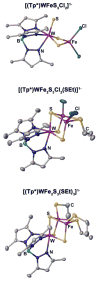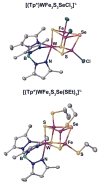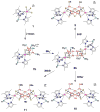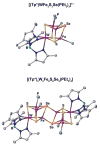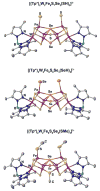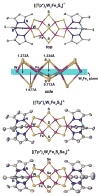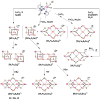Selenium as a structural surrogate of sulfur: template-assisted assembly of five types of tungsten-iron-sulfur/selenium clusters and the structural fate of chalcogenide reactants - PubMed (original) (raw)
. 2012 Apr 11;134(14):6479-90.
doi: 10.1021/ja3010539. Epub 2012 Apr 3.
Affiliations
- PMID: 22424175
- PMCID: PMC3353770
- DOI: 10.1021/ja3010539
Selenium as a structural surrogate of sulfur: template-assisted assembly of five types of tungsten-iron-sulfur/selenium clusters and the structural fate of chalcogenide reactants
Bo Zheng et al. J Am Chem Soc. 2012.
Abstract
Syntheses of five types of tungsten-iron-sulfur/selenium clusters, namely, incomplete cubanes, single cubanes, edge-bridged double cubanes (EBDCs), P(N)-type clusters, and double-cuboidal clusters, have been devised using the concept of template-assisted assembly. The template reactant is six-coordinate [(Tp*)W(VI)S(3)](1-) [Tp* = tris(3,5-dimethylpyrazolyl)hydroborate(1-)], which in the assembly systems organizes Fe(2+/3+) and sulfide/selenide into cuboidal [(Tp*)WFe(2)S(3)] or cubane [(Tp*)WFe(3)S(3)Q] (Q = S, Se) units. With appropriate terminal iron ligation, these units are capable of independent existence or may be transformed into higher-nuclearity species. Selenide is used as a surrogate for sulfide in cluster assembly in order to determine by X-ray structures the position occupied by an external chalcogenide nucleophile or an internal chalcogenide atom in the product clusters. Specific incorporation of selenide is demonstrated by the formation of [WFe(3)S(3)Se](2+/3+) cubane cores. Reductive dimerization of the cubane leads to the EBDC core [W(2)Fe(6)S(6)Se(2)](2+) containing μ(4)-Se sites. Reaction of these species with HSe(-) affords the P(N)-type cores [W(2)Fe(6)S(6)Se(3)](1+), in which selenide occupies μ(6)-Se and μ(2)-Se sites. The reaction of [(Tp*)WS(3)](1-), FeCl(2), and Na(2)Se yields the double-cuboidal [W(2)Fe(4)S(6)Se(3)](2+/0) core with μ(2)-Se and μ(4)-Se bridges. It is highly probable that in analogous sulfide-only assembly systems, external and internal sulfide reactants occupy corresponding positions in the cluster products. The results further demonstrate the viability of template-assisted cluster synthesis inasmuch as the reduced (Tp*)WS(3) unit is present in all of the clusters. Structures, zero-field Mössbauer data, and redox potentials are presented for each cluster type.
© 2012 American Chemical Society
Figures
Figure 1
Depiction of the conversion of the edge-bridged double cubane cluster [(Tp)2Mo2Fe6S8(PEt3)4] to PN-type clusters by reaction with HS− or HSe− in acetonitrile. Note the _μ_2 position of selenide in the product cluster.
Figure 2
Synthetic scheme for incomplete cubane (2, 3, 4) and cubane-type clusters 5ab from template precursor 1. Clusters 6ab and 7ab are obtained from 5ab by ligand substitution reactions.
Figure 3
Structures of the incomplete cubane clusters 2, 3, and 4. In this and succeeding figures, 50% probability ellipsoids are shown. Disorder in the chloride ligands of 3 is evident. Selected dimensions (Å, deg) of 2: W=S 2.159(1), W–S 2.292(2), Fe–S 2.255(1), W–Fe 2.724(1), S–Fe-S 102.83(3).
Figure 4
Structures of the cubane-type clusters 5b and 6b revealing the specific incorporation of a _μ_3-Se atom in the cores.
Figure 5
Synthetic scheme for diselenide edge-bridged double cubane cluster 8b by reduction of single cubane 7b and its conversion to PN-type clusters 9, 10, and 11 by reaction with sulfide or selenide nucleophiles.
Figure 6
Structure of the cubane-type clusters 7b and its edge-bridged double cubane reduction product 8b (imposed centrosymmetry); note the _μ_4 positions of the two selenide atoms. Ethyl groups have been omitted for clarity. Selected distances (Å): Fe···Fe 3.053(3) (bridge rhomb), Se···Se 3.832(3), W···W 8.347(5).
Figure 7
Structures of the PN-type clusters 9 (155.34(4)•), 10 (150.99(5)•), and 11 (159.6(4)•), each of which contains a _μ_6-Se atom. The bottom structure contains disordered Se and SMe bridges in the _μ_2 positions. For clarity, a structure without disorder is depicted. The largest Fe–(_μ_6-Se)–Fe angle involving Fe atoms with terminal ligands is given for each cluster.
Figure 8
Synthetic scheme for double-cuboidal clusters 12–15 based on the reactions of FeCl2 and sulfide or selenide with 1 or 2.
Figure 9
Cyclic voltammograms (100 mV/s) of double-cuboidal clusters 13 and 15 in DMF at ambient temperature; peak potentials area indicated.
Figure 10
Structures of double-cuboidal clusters 12 (monoclinic form), 13, and 15 viewed down a real or idealized _C_2 axis. The side view of 12 is normal to the W2Fe4 plane and shows atom displacements (Å) from that plane.
Figure 11
Summary of sulfide and selenide incorporation in core structures of four cluster types. The core rearrangement in the lower part of the left-hand column is depicted in full in Figure 1.
Chart 1
Designation of Clusters and Abbreviations
Chart 1
Designation of Clusters and Abbreviations
Similar articles
- Specific incorporation of chalcogenide bridge atoms in molybdenum/tungsten-iron-sulfur single cubane clusters.
Majumdar A, Holm RH. Majumdar A, et al. Inorg Chem. 2011 Nov 7;50(21):11242-51. doi: 10.1021/ic2018117. Epub 2011 Oct 10. Inorg Chem. 2011. PMID: 21985054 Free PMC article. - Edge-bridged Mo2Fe6S8 to pN-type Mo2Fe6S9 cluster conversion: structural fate of the attacking sulfide/selenide nucleophile.
Berlinguette CP, Holm RH. Berlinguette CP, et al. J Am Chem Soc. 2006 Sep 13;128(36):11993-2000. doi: 10.1021/ja063604x. J Am Chem Soc. 2006. PMID: 16953641 - Structural Conversions of Synthetic and Protein-Bound Iron-Sulfur Clusters.
Holm RH, Lo W. Holm RH, et al. Chem Rev. 2016 Nov 23;116(22):13685-13713. doi: 10.1021/acs.chemrev.6b00276. Epub 2016 Nov 8. Chem Rev. 2016. PMID: 27933770 Review. - Mössbauer spectroscopy of Fe/S proteins.
Pandelia ME, Lanz ND, Booker SJ, Krebs C. Pandelia ME, et al. Biochim Biophys Acta. 2015 Jun;1853(6):1395-405. doi: 10.1016/j.bbamcr.2014.12.005. Epub 2014 Dec 10. Biochim Biophys Acta. 2015. PMID: 25498248 Review.
Cited by
- Catalysis-dependent selenium incorporation and migration in the nitrogenase active site iron-molybdenum cofactor.
Spatzal T, Perez KA, Howard JB, Rees DC. Spatzal T, et al. Elife. 2015 Dec 16;4:e11620. doi: 10.7554/eLife.11620. Elife. 2015. PMID: 26673079 Free PMC article. - Organic Selenium induces ferroptosis in pancreatic cancer cells.
Noè R, Inglese N, Romani P, Serafini T, Paoli C, Calciolari B, Fantuz M, Zamborlin A, Surdo NC, Spada V, Spacci M, Volta S, Ermini ML, Di Benedetto G, Frusca V, Santi C, Lefkimmiatis K, Dupont S, Voliani V, Sancineto L, Carrer A. Noè R, et al. Redox Biol. 2023 Dec;68:102962. doi: 10.1016/j.redox.2023.102962. Epub 2023 Nov 20. Redox Biol. 2023. PMID: 38029455 Free PMC article. - Analysis of early intermediate states of the nitrogenase reaction by regularization of EPR spectra.
Heidinger L, Perez K, Spatzal T, Einsle O, Weber S, Rees DC, Schleicher E. Heidinger L, et al. Nat Commun. 2024 May 13;15(1):4041. doi: 10.1038/s41467-024-48271-8. Nat Commun. 2024. PMID: 38740794 Free PMC article. - Opportunities for Insight into the Mechanism of Efficient CO2/CO Interconversion at a Nickel-Iron Cluster in CO Dehydrogenase.
Newman-Stonebraker SH, Gerard TJ, Holland PL. Newman-Stonebraker SH, et al. Chem. 2024 Jun 13;10(6):1655-1667. doi: 10.1016/j.chempr.2024.04.012. Epub 2024 May 16. Chem. 2024. PMID: 38966253 - Synthetic Active Site Model of the [NiFeSe] Hydrogenase.
Wombwell C, Reisner E. Wombwell C, et al. Chemistry. 2015 May 26;21(22):8096-104. doi: 10.1002/chem.201500311. Epub 2015 Apr 2. Chemistry. 2015. PMID: 25847470 Free PMC article.
References
- Lee SC, Holm RH. Chem Rev. 2004;104:1135–1157. - PubMed
- Holm RH, Simhon ED. In: Molybdenum Enzymes. Spiro TG, editor. Wiley; New York: 1985. pp. 1–87.
- Malinak SM, Coucouvanis D. Prog Inorg Chem. 2001;49:599–662.
- Abbreviations are given in the Chart 1.
Publication types
MeSH terms
Substances
Grants and funding
- R01 GM028856-31/GM/NIGMS NIH HHS/United States
- R01 GM028856-32/GM/NIGMS NIH HHS/United States
- GM-28856/GM/NIGMS NIH HHS/United States
- R37 GM028856/GM/NIGMS NIH HHS/United States
- R01 GM028856/GM/NIGMS NIH HHS/United States
LinkOut - more resources
Full Text Sources
Medical
Research Materials


